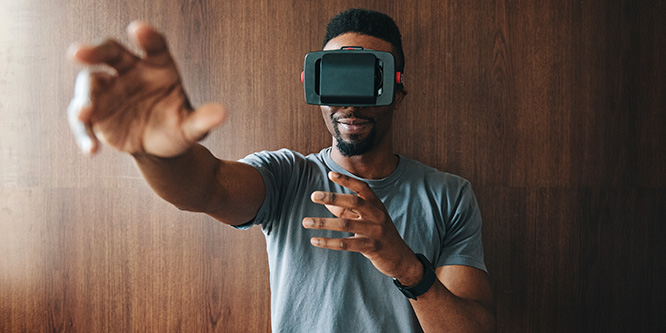
Photo: @daphneemarie via Twenty20
July 30, 2021
What’s holding consumers back from adopting AR/VR shopping tech?
Less than half of consumers claim interest in using virtual or augmented reality tools before making a purchase, although it depends on the category, according to a global YouGov survey.
For clothing, 43 percent of consumers were interested in using AR/VR pre-purchase. That compares to technologies/home appliances, 36 percent; furniture, 29 percent; and video games, 20 percent.
Interest skewed higher among younger respondents, offering hope for greater acceptance as younger generations age. Among 18-to-24 year olds, interest in using AR/VR in shopping for clothes was at 52 percent; technologies/home appliances, 40 percent; furniture, 32 percent; and video games, 38 percent.
The survey was fielded from January to February.
With stores off limits or restricted, adoption of “try-before-you-buy” AR/VR experiences was expected to have accelerated during the pandemic. Marketers rolled out numerous executions across fashion, beauty, furniture and other categories to strong press coverage, but it’s unclear how warmly they were embraced.
Euromonitor’s “Voice of the Consumer: Digital Survey,” taken in March, also found fairly low enthusiasm, despite the years-long availability of AR and VR technologies. Fifty-eight percent of connected consumers globally reported not having used either.
Of those that have used AR/VR in the past year, 71 percent used it to play games. Thirty percent utilized the technology to shop for household items and furniture as well as clothes, up slightly from 2020. Fewer than 30 percent thought the ability to virtually try on clothing was an important online feature.
Among social media channels, Facebook and Snapchat have been touting the use of A/R as they build out their e-commerce capabilities.
Snap, the parent of Snapchat, in mid-July acquired Vertebrae, which helps brands make digital 3D-versions of their products, and partnered with luxury e-commerce site Verish to jumpstart its e-commerce ambitions.
On its second-quarter call last week, Snap officials said more than 200 million now engage daily on average with AR on Snapchat and over 200,000 creators use Lens Studio to build AR Lenses.
Jeremi Gorman, Snap’s chief business officer, said, “We know that AR can play a really pivotal role in improving the commerce experience for shoppers that’s been beneficial to both the retailer and the customer.”
- International Omni-Channel Retail Report 2021 – YouGov
- Using Retail Tech Innovation to Enhance the Customer Experience – Euromonitor International
- More than Half of Retail Professionals Say Pandemic Accelerated Tech Product Launches – NRF
- How AR Is Redefining Retail in the Pandemic – Harvard Business Review
- Snapchat cements AR ecommerce as a top priority ahead of Q2 earnings – eMarketer
- Snap inc (SNAP) Q2 2021 Earnings Call Transcript – Snap
- Has augmented reality tech reached an inflection point at retail? – RetailWire
Discussion Questions
DISCUSSION QUESTIONS: Should the apparent slow adoption of AR and/or VR for e-commerce cause concern? How confident are you that AR/VR will one day be a widely used tool for online shopping?
Poll
BrainTrust
Dr. Stephen Needel
Managing Partner, Advanced Simulations
Raj B. Shroff
Founder & Principal, PINE
Recent Discussions







Augmented reality has a lot of potential, especially in terms of allowing customers to see how products like furnishings look in their rooms, and there has been take up of the technology. Virtual reality, complete with headsets, is less appealing. It’s a hassle, can be cumbersome, and often doesn’t really add much value. I have seen virtual reality grocery experiences that the developers thought would be the next big thing. Frankly, the whole thing was terrible and it took way longer to order than going to a static webpage or even to a normal store.
This comes down to the old truism with retail technology: start with the problem, then develop the technology solution; don’t start with the technology and then try and find a “problem” to solve!
Excellent point. Unless the technology solves a problem to make shopping easier and more successful, the technology adoption rate will be very slow.
I’ve been doing VR for 28 years now and we’ve never seen much desire to adopt in every day life. For the most part, existing applications are fairly lame — VR applications tend to be cartoonish in many cases. Making them look really real calls for deep pockets. It’s not going to be a widely used tool for online shopping for some time to come. Don’t hold your breath waiting for this to happen.
I see AR/VR in the shopping experience as only slightly accretive at best. Use cases like seeing a room with furniture or rugs etc. have value, but I don’t know how much real value seeing an outfit on a virtual person will be trusted. Not to mention, there’s a certain % of the population where VR headset just cause dizziness and nausea (ahem, hand raised).
It’s on retailers to clearly demonstrate the value in AR and VR for e-commerce. Many brands have announced their use of it, but not explained how it works and how close to in-person trial it actually is. There’s too much mystery still surrounding AR and VR for consumers to excitedly adopt it.
I would also point to how long it took consumers to embrace omnichannel services such as BOPIS, curbside, and QR codes to argue that adoption will take time. Consumers are quite slow at shifting their shopping behaviors. They’re very set in their ways and only leverage new tools when a strong use case for them is made. So, if retailers make that strong use case, then I’m confident AR/VR will end up widely used for online shopping.
A couple of things: 1) the tech is just not that good yet — it’s awkward, cartoon-like and you stumble around into things like a lost pony … plus 2) REAL shopping is still better and too close to what we’re used to.
Give it a couple more generations of non-physical shoppers and improved tech and it’ll be off and running. I wouldn’t give up on it. Remember, revolutions can take decades. It’s taken 25 (sometimes crazy) years to get e-com to 20%.
As has been my answer to many other questions on this forum, it depends on the product category. Nobody needs AR/VR to buy a screwdriver online, but consumers might want to see a specific piece of clothing on an avatar that walks and turns so they can see it from all angles. You get the analogy….
AR/VR certainly has promise, but in my opinion, it’s still got a ways to go until it becomes a more seamless part of the shopping experience. Often times, AR/VR experiences require special apps which is always a barrier to adoption. To drive adoption, any experience has to add real value to the journey, and for the most part, the AR/VR experiences offered today feel more like novelties than real meaningful tools that assist in the decision process. And those that do attempt to help with the decision typically don’t go far enough. How many people look at a shirt superimposed on their bodies via AR and think that it’s a realistic — and truly helpful — representation of how the shirt will look or fit? I think live streaming — especially associate live streaming — does a great job of helping people really get a sense of the merchandise virtually, and until AR/VR improves, I suspect most will turn to live streaming.
I used AR/VR from time to time. Once the initial enthusiasm wears off, it is not a sticky platform. Content is the main challenge.
To see what will take AR/VR to make impact on shopping, we only need to look at gaming. For better part of 15 years, we have had immersive gaming consoles and games. Still the e-commerce generated from within games is insignificant.
To monetize AR/VR for e-commerce is a long road ahead. AR/VR as shopping tool already makes sense and used in apparel, home decor, glasses etc.
A major barrier has to be the different platforms that are available and the entry cost. While there are multiple mobile options available, really immersive options like Oculus require expensive kit in order to function. It is unlikely that this is something people will want to part money for purely for shopping. Where it is being used for other purposes — gaming for example — this could well become an entry point for retailers targeting shoppers who have already purchased a headset for that purpose.
The short answer is, the technology needs to improve before consumers adopt it. I’ve never even seen AR that’s easy to use–except when it’s in a physical store–and even that’s pretty unsatisfying.
My opinion has been that VR ads friction to the digital shopping experience. My sense is most people want the fastest, easiest path from item to basket to checkout. Target and Walmart have focused on improving search, making it easier to create a list, and streamlining the check out process. Strapping on a device and wandering around a virtual store looking for products makes this process a lot more tedious. More fun, but more tedious for day to day shopping.
Tt seems to me that creating high use of AV/VR relies on consumer acceptance. However, in our consumer focus groups, we always find that customers will change habits slowly, when convinced by trial, proving to themselves what is better for them. I think it will take more work and information to consumers to adopt the use of AV/VR anywhere. Habits are hard to break, and even harder to create.
I put online shopping into 2 categories. My kids and I call the 1st “Dad shopping,” which means you have a short list, and go get the things on that list as quickly as possible. “Mom shopping” means (in my family) having a list, and some other “ideas” and getting inspired on that journey to get the things on the list. Execution vs. Discovery. I think AR/VR has its place when it comes to discovery, but gets in the way of execution. As with all consumer facing retail tech, I am enthusiastic about the innovation and iteration and fully expect that “one day” the tech enabled shopping experience will be vastly different from what it is today, and that there shouldn’t be “concern,” just an expectation that adoption will require many innovative iterations.
First, in order for a brand to deploy AR or VR, they need to understand the difference and not lump the terms together.
AR, implemented with realistic expectations that are user-focused, not brand-focused can add value today. For example, empowering customers walking a furniture store to point their phone’s camera at items (with an app) and see basic product data like dimensions and price overlayed on the live image (which is what augmented reality is). It’s easy and adds convenience to shopping.
VR, which creates simulations (worlds) is still laden with issues and requires typically wearing uncomfortable goggles and usually has a small learning curve that differs with each application. Shoppers have not been acclimated to that experience and most probably aren’t incentivized enough to put the acclimation time in. A related example would be laying out a room with furniture and “walking” it in simulation. There are benefits, but it’s more effort.
I’m a technology guy, but technology for technology’s sake is always a failure and not making user-centered design decisions that add value for the customer is equally bad. Until brands authentically consider all of this, AR and VR will not flourish.
I don’t think the slow adoption should cause concern. AR/VR can create great experiences, but the hardware interfaces are clunky. When the AR/VR provides real fun or function, people are willing to overcome the hardware hurdles (small screens, goggles on the head, etc).
I am fully confident they will be used for ecommerce shopping (or meta-commerce) it will be the younger generation and likely Asian markets that will adopt it at a more rapid pace. As for “widely,” like Gibson said, “The future is already here – it’s just not evenly distributed.” Like Melissa said, look how long we talked about BOPIS before retailers made it possible. As tech savvy folks get more involved in retailers and as tech platforms like FB push into the space, we’ll see the change.
I think the social connections people made across video during covid helped us realize how close we can be to someone far away. I think that idea will come to shopping very soon and AR/VR tools will enable that. While shopping in person with friends is fun, I can’t fly to London today to shop with my friend, but I will soon be able to do that virtually.
The evidence is pretty clear that consumers have embraced VR primarily for gaming, which makes great sense, both in its use case as well as the demographic. Broader adoption of AR/VR for e-commerce shopping, across age groups, will not only take much more time, it will likely always represent a small subset of shoppers.
Lack of adoption can be attributed to the technologies being highly niche offerings, combined with absence of consumer awareness and absence of compelling reasons to use it — as in, although it may be cool technology with long-term potential, it doesn’t reduce customer effort. It is less about what’s holding consumers back and more about there’s simply no interest in it (clear need) — at least for now.
I am not concerned about the rate of adoption. Granted, there has been significant hype over both AR and VR (and by extension Mixed Reality, MR). I continue to believe AR will see more adoption than VR because it has less friction for the consumer.
AR can immediately deliver value if the consumer has the appropriate device. We see many mobile apps leverage this to allow consumers to see products in their home or to overlay product data when viewing an item in store. The hurdle here is on the developer side and that is rapidly changing as more toolkits are made available across the major dev platforms to enable this.
VR, on the other hand, has hardware hurdles to overcome. Headsets, gloves, and other hardware typically required make the experience clumsy for many users. There are more VR applications outside of retail shopping (warehouses, distribution, product development) that will see adoption before consumer retail applications. Mixed Reality may hold more hope for consumer applications in the years to come before pure VR applications take off.